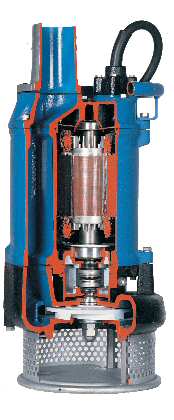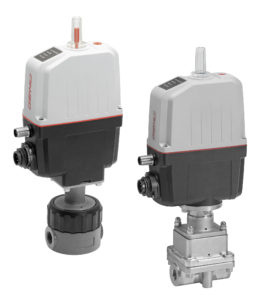Prevent Burst Pump-casings in Freezing Conditions
If you are pumping clear or dirty water at temperatures below zero °C, you should take precautions.The first thing to mention here is that it is vitally important to clear the pump of fluid when it is not in use.

Cut sample of a sludge pump
If this is not done, there is a danger of leakage, cracking or even complete bursting of the pump-casing.
When frozen, standing water in the pump increases in volume by up to 9%. In a worst-case scenario this can be enough to make a clean break in the pump-casing, which are usually made of cast iron or aluminium. And it is impossible to design against this breakage – even stronger materials would suffer the same effect against the sheer natural force of frozen water.
Key considerations
But it’s not only water temperature to keep an eye on, there are other considerations too as Ole Hellem of Intec, the Tsurumi dealer for Norway, explains.
“To pump below-average temperature media does not normally cause problems on its own,” he says. “But you should make concessions for the fact that your pump will operate with a lower pumping capacity because media at lower temperatures will pump at a decreased flow rate.”
When water is pumped in frosty weather, experts point out that surface water is cooler than water in lower layers. This is important to note when working in deep wells or with the groundwater that has accumulated in a sump pit.
“And the danger of pumping in freezing conditions increases when working on above ground construction projects,” says Hellem.
When the pump is working in ‘interval’ mode or in suction mode, if there is only a small amount of water being pumped (or the pump is running dry occasionally) there is a danger the pump may freeze tightly. One further consideration is that different media have different consistencies and therefore different freezing points, which must be taken into account.
Remember the greasing
Beside the media being pumped there is another liquid vital to the smooth running of pumps in freezing conditions and that is the lubricant oil, without which no pump can operate. The viscosity of lubricant oil decreases at lower temperatures, which in turn raises the issue of possible pump malfunction due to insufficient lubrication. Even if the weather conditions are arctic, a pump running hot will ruin itself. However, effective protection and peace of mind against this permanent damage is offered by Japanese-made pumps. These pumps have a special oil-lifter that supplies the mechanical components with enough lubricant at all times – no matter if the pump is standing or lying, operating in summer or winter temperatures.
One final thought. With all this attention on the pump it is important not to forget the inlet and discharge outlet. Keep these clear and smooth running because the dangers of frost will not stop simply because they come to the weakest link in the chain.
About Tsurumi
Tsurumi is one of the world’s most experienced pump manufacturers. From its modern facility in Kyoto, Tsurumi produces more submersible pumps globally per year than any other pump manufacturer. There are currently over 1800 different pump models in the Tsurumi range, including semi-vortex, vortex, non-clog, cutter, contractor & dewatering, sewage & wastewater, aerators & blowers, decanting units and scum skimmers. Tsurumi operates on a worldwide basis with an extensive dealer network in Europe, North and South America, Asia, Australia and parts of Africa.
Source: Tsurumi (Europe) GmbH


